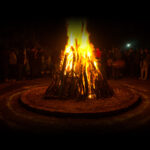Calennig celebrated on January 13 every year, is the Welsh tradition of celebrating and welcoming the New Year. Did you know that ‘Calennig’ is a Welsh word that is derived from the Latin word ‘kalends’ which translates to ‘the first day of the month’? While many countries have adopted the Gregorian calendar, a village in Wales, known as Cwm Gwaun, is still using the Julian calendar — hence celebrating New Year 13 days later. Nonetheless, the celebration was, and still is spectacular! On Calennig, people of Wales exchange gifts, sweets, or even money with their family and friends to welcome the new year on a good note. Let’s learn about the years-old tradition of Calennig.
History of Calennig
Throughout the world, the months of December and January are favorite months of the year because it is the holiday season! Christmas and New Year celebrations happen in every corner of the world in full swing and Wales is no exception. Calennig is the Welsh equivalent of New Year’s Day and is celebrated on the first day of the new year according to the Julian calendar. The people of Cwm Gwaun have preserved old traditions and celebrate this day according to how their ancestors did in the 17th century. Till today, young boys visit each house in the village to splash the villagers with water that they retrieved from the local well. This activity is seen as a symbol of good fortune. In return, the villagers are expected to give the Calennig — a small gift, usually in the form of copper coins. Unfortunately, the history and origin of Calennig are not well known and several folklores are surrounding it. But historians believe that Calennig must have evolved from the ancient custom of giving gifts and money on New Year’s Day. One thing we do know is that Cwm Gwaun, Pembrokeshire, is keeping this tradition alive and celebrating it on January 13 each year. However, over the years the customs have evolved differently in many areas of Wales. In some areas, the celebration takes place in the form of the chanting of a small verse or two in exchange for small coins. While in other areas, the tradition of water splashing is still at large.
Calennig timeline
The country of Wales is discovered.
Most parts of Wales switch from the Julian Calendar to the Gregorian calendar system.
Fred Hando illustrates the Calennig festival in his book called “The Pleasant land of Gwent.”
People across Wales begin to revive this old festival once again.
Calennig FAQs
How do I celebrate Calennig?
Grab the greenest branch you can find in a tree and fetch a cup of water from a nearby well or any water body. Stick the branch in the cup of water and splash!
Is Calennig celebrated on the same day every year?
Yes, usually, Calennig or Welsh New Year is celebrated on January 13 in some parts of Wales. But it varies in many parts of the country.
Is First Footing and Calennig the same?
No. Although both holidays are celebrated on New Year’s Day, First Footing follows the Gregorian calendar (January 1) and Calennig follows the Julian calendar (January 13). Also, the two holidays may have similar meanings but have very different styles of celebration.
Calennig Activities
-
Be the one to gift
Well, the greatest pleasure you can gain on Calennig is by gifting copper coins or anything you’d like to give as a gift to someone you’re thankful for.
-
Do it the old way!
Want to enjoy the celebration in its original form? Get the greenest twig you can find and gather your boys, it's the fun of a lifetime! Observe the tradition of splashing water with your friends and family.
-
Share your favorite Calennig story
Calennig is one of the exciting and heart-warming festivals out there. So, if you have some interesting stories that happened in your childhood, share them on your social media!
5 Amazing Facts About New Year Traditions That’ll Take You Into Celebration Mode
-
New Year is 4,000 years old
The first New Year’s Day celebration dates back to 4,000 years ago.
-
Green food, good life!
Tradition says that the more greens a person eats on New Year’s Day, the more prosperity the person will experience that year.
-
Caesar invented the New Year celebrations
Julius Caesar, the emperor of Rome, was the first to declare January 1 as a national holiday.
-
January — a god
Caesar named the month of January after the Roman god Janus
-
Sint Sylvester Vooravond
People in Belgium call ‘New Year’s Eve’ ‘Sint Sylvester Vooravond’ where children write letters to parents with good wishes and lots of love.
Why We Love Calennig
-
Calennig is a tradition that has to be remembered
Each country has its own way of celebrating the New Year and Calennig is a unique and interesting tradition that is observed in Wales. It is our duty to protect these kinds of good traditions.
-
It teaches us the joy of giving
Calennig teaches us the joy of giving. The person who gets splashed with the well water would have to offer the children some gifts. This is not just restricted to children; we can gift anyone we’re thankful for on Calennig.
-
It’s all about celebration
Calennig, or New Year’s Day, is all about celebration and happiness. This is one of the very few days when people forget all their differences and rejoice with others.
Calennig dates
| Year | Date | Day |
|---|---|---|
| 2023 | January 13 | Friday |
| 2024 | January 13 | Saturday |
| 2025 | January 13 | Monday |
| 2026 | January 13 | Tuesday |
| 2027 | January 13 | Wednesday |























